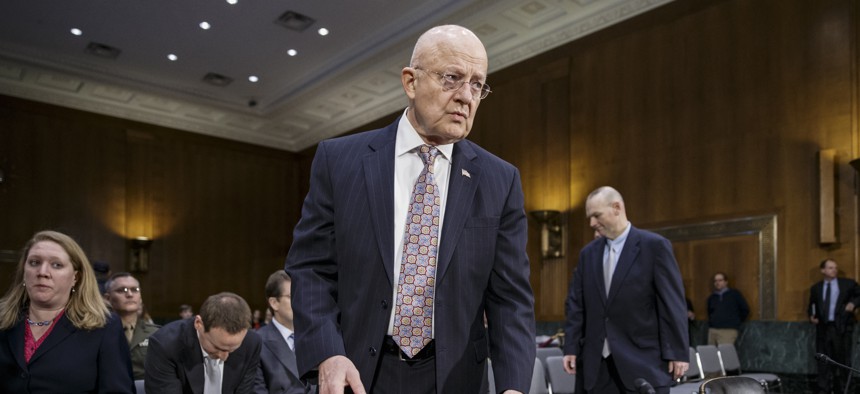
Director of National Intelligence James Clapper arrives on Capitol Hill in Washington, Thursday, Feb. 26, 2015, to testify before the Senate Armed Services Committee. J. Scott Applewhite/AP
Intelligence Reform 2.0
Here are six ways to make sure America’s leaders and troops get the intel they need.
Ten years ago this month, the American intelligence agencies were reorganized to prevent another 9/11. Now the Intelligence Community needs even more radical transformation as national-security challenges grow, budgets decrease, and questions arise about intelligence’s place within an open society. The key to addressing these challenges will be building a more integrated intelligence enterprise that demonstrates its value to the American people. We recommend six major initiatives.
1. The CIA must fully implement its reorganization plan.
In a shake-up, the CIA is creating mission centers to integrate its capabilities around specific subjects and geographic regions. The agency has successfully beta-tested this kind of collaboration for years, but if the past is prologue, this reform will be arduous in an organization that is averse to major reforms. For this transformation to succeed, CIA will need to foster the highest level of skills necessary for successful clandestine operations and analysis, establish clear career development paths for its personnel, and ensure ongoing support from the President well past 2016.
2. The President and Congress must empower a jointly operated cyber center.
Offensive and defensive cyber capabilities are currently dispersed among the National Security Agency, the military’s Cyber Command, the Department of Homeland Security, the FBI, the CIA, and other agencies that perform boutique operations. Instead of this jumble, responsibility for cyber policy and the general direction for operations should be centralized, even if a variety of agencies continue to execute that policy. The new Cyber Threat Intelligence Integration Center is a start, but its mission is limited to compiling available information on cyber threats. To make a real impact, it will have to butt heads with entrenched bureaucratic interests. Securing the country’s digital domain may require legislation and, certainly, a commitment from the White House to end the bureaucratic turf wars.
3. Bring more domestic information into the Intelligence Community.
Information-sharing between the Department of Homeland Security and the Intelligence Community remains elusive for several reasons: different bureaucratic cultures, an absence of clear data-sharing policy, and incompatible information technology within the Executive branch. We need to do better. Consider how a more integrated system might work: A foreigner entering the U.S. from Mexico arouses suspicion. Border patrol searches his cell phone, which reveals calls made to Syria. That information is passed to an intelligence analyst in Washington who identifies the numbers as associated with Islamic extremists. The foreigner is prevented from entering the country where he intended to launch an attack. Connecting these kinds of data is critical to improving our ability to protect the homeland.
4. The Defense Department needs to strengthen the Defense Intelligence Agency (DIA) as the hub of military intelligence.
Today, every uniformed military service, from the Air Force to the Marine Corps, has its own intelligence unit. While there are benefits to this approach, operational and analytical techniques are not uniform across the services so some military intelligence is better than others. To remedy this problem, the DIA should have the responsibility to set and enforce tradecraft standards for all of the services’ collection and analysis. This change will help intelligence produced by each service to meet a uniform quality standard. It will also allow the services to focus more on delivering the best intelligence to the battlefield.
5. The Intelligence Community needs to create an integrated workforce.
An integrated enterprise begins with integrated personnel. Far more intelligence officers need to go on short-term—called “joint duty”—rotational assignments outside of their home agencies. A CIA officer, for example, might take a two-year tour of duty at the Treasury Department, where she would work to stop the financing of terror groups. Such assignments benefit the agencies and expose officers to different skills and approaches to problem-solving while helping them build an interagency network. Joint-duty postings should be open to all officers at all stages of their careers.
6. The DNI should create a National Intelligence Leadership Corps.
Exceptionally high-performing intelligence officers should be inducted into a National Intelligence Leadership Corps. These officers would rotate through high-level positions in several agencies. This Corps would number no more than 100, and its members would have experience in intelligence and policy agencies through multiple joint-duty assignments. With these experiences, they would embody the integrated, collaborative Intelligence Community the country needs.
To realize these reforms, the next President will need the right intelligence team. The President’s selection of intelligence leaders has often focused only on the Director of National Intelligence and the Director of the CIA. But the President must consider a broader group—including the Undersecretary of Defense for Intelligence and the Principal Deputy DNI—and select a team committed to the integrated model of intelligence.
How organizations are designed determines how well they work. Today, the threat environment has radically changed, and, collectively, its challenges are greater than those we faced even a decade ago. To remain relevant, the Intelligence Community must accelerate its own transformation. We cannot afford to be timid with the work that lies ahead.
NEXT STORY: It's Time To Figure Out What Putin Wants



